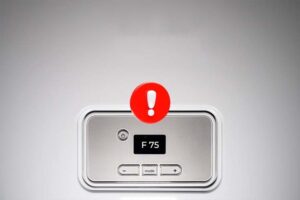Table of Contents
Radiators keep your home warm, which may be, let’s say, essential during the cold UK winter seasons. During summer, you might not even need them on at all, especially throughout July and August. Even in winter, there are good reasons to turn some radiators off or lower their heat.
For example, if you have rooms that are not in use, then it is really a waste to keep the radiator on. Because it also increases energy consumption. You might as well turn the radiators off when replacing them or if you are going to go away on a very, very extended vacation.
Understand how to properly turn a radiator on or off, and that will keep you comfortable while saving energy. In that respect, here is a step-by-step guide on how to operate your UK-style radiators on/off and answer some questions along the way.
Understanding Radiators and Their Components
Radiators are a simple, effective way to warm up your home. They work by having hot water or steam circulated through their panels, which in turn heat up the surrounding air. Once installed, they quietly do their job without much effort on your part.
Before turning a radiator on or off, it’s useful to understand how it works. The main components you’ll be dealing with are the radiator valves, which control the heat, and the thermostats, which help manage the temperature.
Knowing these basics will make it easier to adjust your heating, save energy, and keep your home warm when you need it. Now, let’s take a closer look at radiator valves and their functions.
1. Radiator valves
Radiator valves control the quantity of hot water entering your radiator, which in turn dictates how much heat it gives out. There are three main types:
TRV stands for Thermostatic Radiator Valve
TRVs have a built-in sensor that automatically adjusts the amount of heat coming out of the device, depending on the room’s temperature. You can set them by turning a numbered dial while the rest is left to the system. They save energy by making sure radiators never overheat a room.
Manual Valve
A manual valve works like a tap – you turn it up, and hot water comes in. You turn it down, and the heat reduces. Unlike TRVs, which work automatically, the setting changes are made in a manual valve by the individual requiring changes.
Lockshield Valve
The lockshield valves are not meant to be used as a routine regulation type. They regulate how much water the radiator receives to balance the heating system.
These are normally topped with a plastic cap and do not have a numbered dial. The lockshield valve should only be adjusted when installing or balancing a radiator.
How to Identify Radiator Valves
If you don’t know which valve is which, here’s how to tell them apart:
- Most thermostatic valves are of the numbered dial type for the control of temperature.
- Manual valves look similar but do not have automatic settings.
- The lockshield valves are of a smaller size and are covered with a plastic cap in order to avoid unintentional adjustments.
An easy way to identify them is to wait until your heating is on, then check which side of the radiator heats up first. This is where the thermostatic or manual valve is located.
2. Thermostats
Some of the new radiators feature an integrated thermostat that can control different temperatures in each room. That’s a good efficient way to save energy by heating what you are only going to use.
3. Bleed Key
A bleed key is a small tool used to release the trapped air in your radiator. Sometimes, as time goes by, air can get stuck inside and prevent the radiator from heating up evenly. Using a bleed key improves efficiency and keeps your radiator working correctly.
Why Turn a Radiator Down or Off?
There are many practical reasons why you might want to turn a radiator down or completely off. Here are a few common scenarios:
1. When away from home
If you are going on holiday or leaving your home empty for a while, try turning the radiator down a notch. There is no point in keeping an empty house warm.
2. Unused rooms
In rooms that are seldom used, like a guest bedroom or storage space, turning down or turning off the radiator saves energy.
However, it may be even more advantageous to have it on low instead of off altogether for the sake of long-term savings. Since it would prevent any issues with dampness or frozen pipes.
3. Balancing heating costs
This also serves to lower heat in the less-used rooms and helps focus warmth where needed without wasting energy.
Apply for Free Boiler Replacement!
Turning Off a Radiator versus Isolating a Radiator
It is important to know the difference between the two: turning off a radiator and isolating it altogether.
To turn a radiator off:
This means closing the valve in the radiator to prevent it from heating the room. However, the hot water still circulates in the system of the radiator, hence the pipes remain warm and do not freeze during the colder months.
Isolating a radiator:
Isolating, in this context, means the total stoppage of water feeding to the radiator. This is done usually for the purpose of repair, decoration, or replacement of a radiator. It is a bit more involved and requires extra care since any trapped water may freeze and damage pipes or the radiator.
How to Turn Off a Radiator Valve?
Turning off a radiator is pretty straightforward, yet the procedure to follow exactly changes with the valve type. Depending on what’s fitted – a thermostatic or manual valve – on your radiator, this is done one way or the other.
Let’s go through the proper procedures below so that it’s done properly, whichever of them you go through.
How to Turn Off a Radiator with a TRV?
If your radiator has a thermostatic radiator valve, do the following:
1. Locate the TRV:
Look for a valve with a dial containing numbers which is usually on the left-hand side of your radiator, towards the bottom.
2. Turn the dial to ‘0’ or the lowest setting:
Turn the dial clockwise to where it reaches ‘0’ or whatever it is that denotes the off mode. Which actually stops the radiator from heating the room.
3. Set to a low temperature if needed:
Or you can just turn it to a very minimal setting so you will avoid frozen pipes. Most TRVs have frost prevention modes during colder months.
How to Turn Off a Radiator Without a Thermostatic Valve?
If your radiator has a manual valve and not a TRV, do the following:
1. Locate the manual valve:
This is usually an easy-to-use knob at the bottom corner of the radiator.
2. To close it, just turn it clockwise:
Turn the valve clockwise until it is fully closed. This will shut off the hot water feeding into the radiator and, in essence, turn it off.
3. Check the lockshield valve:
Try not to touch the lockshield valve unless you have to, as this is used to isolate the radiator for maintenance. It’s on the opposite side of the manual valve and is set so that the system is balanced.
How to Turn Off a Radiator with a Manual Valve?
If your radiator is fitted with a manual valve, here’s how you can turn it down or off in a few easy steps:
1. Find the Manual Valve:
First, you will need to seek a simple knob, which is usually at the bottom left or right corner of your radiator.
2. To Open the Valve Clockwise:
Once the valve is turned clockwise to its lowest position, do not fully close it, but rather turn it a tad counterclockwise after that. Fully closing it risks the water inside the valve freezing during colder months. Therefore bursting the pipes and radiator. Unlike TRVs, manual valves do not have any frost protection modes to do this.
3. Lower the Heat Rather than Turning It Off:
To simply decrease the heat, turn the valve to a setting somewhat lower. Check your radiator’s manufacturer instructions to find the most suitable lower temperature for your needs.
How to Turn Off a Radiator Without a Dial?
Some radiators do not have a visible dial or number settings. In these cases, the valve may still be present but in a different form. Try the following:
- Look for a removable cap. Sometimes radiators have a cap over the valve, and if so, carefully pull or twist it off, and it should show you a hidden control.
- Use a wrench or pliers. Where there is no handle, it may be that the valve has to be adjusted with a wrench or pliers. Turn it clockwise to reduce the heat or shut it off.
- Identify where your lockshield valve is. If your radiator is not fitted with a manual or thermostatic valve, this may be because your lockshield controls it. These set the balance to your heating system, so treat it with care while adjusting.
How to Turn a Radiator Off with No Knob?
If your radiator doesn’t have a knob, you can do the following to turn it off:
- Using pliers or a wrench: Grasp the metal stem that the knob would be on and twist clockwise to lower or stop the heat.
- Replace the missing knob with a replacement that would fit your radiator model, making adjustments easier in the future.
How to Turn Down Your Radiator?
If your room is too warm but you do not want to switch the radiators off, here are a few tips to reduce the temperatures:
1. Use a Radiator Cover:
A correctly designed radiator cover, with reflective foil on its backside, does reduce the output of heat with increased efficiency.
2. Wrap the Radiator with a Blanket:
Cover the radiator with a blanket of wool or cotton. It can cut off the amount of heat entering the room, and do not use synthetic fabric, because it can melt easily.
3. Adjust the Water Flow:
Reduce the water flow to a radiator from your boiler. This will lower the flow through the pipes, thus reducing heat output without being completely turned off.
By using these techniques, you can easily regulate the heat in your home without experiencing frozen pipes or inefficiency in heating.
How To Turn On a Typical Radiator?
It is not a big deal to turn on a radiator once you know how to do it. Here’s how:
1. Find Your Radiator
Find the radiator you want and ensure nothing is obstructing it, such as furniture or even curtains. Radiators do need a bit of space around them to really circulate the heat.
2. Check the Thermostat Valve
Look for the thermostat valve (usually on the bottom corner of the radiator). If it’s set to “0” or off, you’ll need to adjust it to start heating.
3. Turn Up the Heat
To do so, turn the valve clockwise to your desired setting. Most radiators have a numbered dial ranging from 0 through 5 or even higher, with the understanding that higher numbers will give added warmth.
4. Ensure the Boiler Is On
Your radiator won’t heat up unless your central heating is on. Check your boiler and set it to a comfortable temperature.
5. Wait for It to Warm Up
Radiators take time to heat up. If even after some time it feels cold, then there might be trapped air inside it. In such a case, bleeding the radiator can do the magic.
How to Turn On a Radiator with Two Knobs?
Some radiators will have two knobs – a manual valve and a lockshield valve. To get them to work, do the following:
1. Locate the Manual Valve
The manual valve is usually on one side of the radiator at the bottom. It controls the flow of water.
2. Turn the Manual Valve
Turn the valve in an anticlockwise direction to open and let hot water flow through.
3. Adjust the Lockshield Valve (if necessary)
On the other side, the lockshield valve allows balancing in water flow, so large turns are not made. If you need to make adjustments, do small tweaks with a spanner.
4. Check for Heat
Wait for a few minutes and then return to see whether the radiator is heating up properly. If it is still cold, then it may well need bleeding or balancing.
How To Turn On a Radiator Valve?
Radiators come in with various types of valves. Operating them is described below for a quick view:
Thermostatic Radiator Valve
TRVs allow setting the temperature in each radiator individually:
- Look for the numbered dial on the valve.
- Set it to your desired level – for example, “3” for moderate heat. The higher the number goes, the hotter it will be.
Manual Valve
A straightforward option for controlling heat:
- It should be turned anti-clockwise to fully open the valve for maximum heat.
- Turn it clockwise to lower the heat by reducing water flow.
Lockshield Valve
This valve equalises water flow across all the radiators:
- When necessary, make minor adjustments with a spanner.
- It is usually set at installation and does not need to be changed routinely.
How Do I Isolate a Radiator?
Isolating a radiator is one of those jobs that you may have to undertake for decorating, repairing, or draining the system. The steps depend on whether your radiator has a thermostatic valve or a manual valve. Here’s a simple guide:
How to Isolate a Radiator with a Thermostatic Valve (TRV)
1. Turn the Lockshield Valve
Locate the lockshield valve, which is usually on the opposite side of the TRV. Completely close it by turning it clockwise. Count the number of turns for your eventual return to this position.
2. Set the TRV to Off
Turn the thermostatic valve to the “off” position on the dial.
3. Use the Decorator’s Cap
Remove the head of the TRV and replace it with the decorator’s cap, usually provided with the valve. This is to ensure that when in frost protection mode, no water will pass through the radiator, and the radiator will be completely isolated.
How to Isolate a Radiator with a Manual Valve
1. Turn Off the Manual Valve
Locate the manual valve and turn it clockwise until it is fully closed.
2. Turn the Lockshield Valve
Turn the lockshield valve clockwise to shut it. Note again how many turns it takes to shut – half a turn, a quarter – anything – so that you can restore it exactly to that setting later.
The Bottom Line
Turning a radiator on or off in the UK is a very easy process. In order to turn such radiators off or on, one needs to turn the valve clockwise to switch it off and counterclockwise to turn it on.
If your radiator has a thermostatic radiator valve, then you need to turn the dial towards your required temperature. If it’s a manual valve, you may need to make slight adjustments for optimal heating.
Remember, in case your radiator isn’t heating properly, check for trapped air and bleed the radiator to fix the problem. Make sure the boiler always stays on for the radiator to heat up.
Frequently Asked Questions
To turn off the radiator, turn the valve clockwise until it’s fully closed. To turn it on, turn it counterclockwise. Use gentle force to avoid damage.
You will be able to expect a lifespan of a decade for a TRV, depending on the quality and maintenance. After ten years, though, it is a good idea to replace them to maintain efficiency.
To check, it should be turned fully clockwise. The radiator is off if it feels cold. Also, make sure the thermostat is at an appropriate temperature setting.
Trapped air may not allow appropriate heating; keep an air bleed key handy to release the air and get going again with your radiator.



